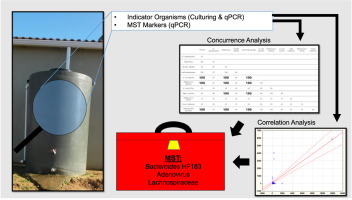Environmental Research ( IF 8.3 ) Pub Date : 2017-12-26 , DOI: 10.1016/j.envres.2017.11.043 M. Waso , S. Khan , W. Khan

|
Domestic rainwater harvesting (tank water) systems were screened for the presence of a panel of microbial source tracking (MST) markers and traditional indicator organisms. The indicator organisms were enumerated utilizing traditional culture-based methods, while the MST markers were quantified by quantitative PCR (qPCR). The indicators Escherichia coli (E. coli) and enterococci were also quantified using qPCR. Correlations and concurrence between these parameters were then investigated to determine which markers could be utilized to supplement traditional indicator analysis. Quantitative PCR analysis indicated that Bacteroides HF183, adenovirus, Lachnospiraceae and E. coli were detected and quantifiable in 100% of the tank water samples collected throughout the sampling period, while human mitochondrial DNA (mtDNA) was quantifiable in 90% of the tank water samples and Bifidobacterium adolescentis (B. adolescentis) and enterococci were quantifiable in 67% of the tank water samples, respectively. Significant positive correlations were recorded for Lachnospiraceae versus heterotrophic bacteria (p = 0.000), adenovirus versus E. coli (culturing) (p = 0.000) and heterotrophic bacteria (p = 0.024), the HF183 marker versus E. coli (qPCR) (p = 0.024) and B. adolescentis versus fecal coliforms (p = 0.037). In addition, 100% concurrence was observed for the HF183 marker, adenovirus and Lachnospiraceae versus E. coli (qPCR), enterococci (qPCR) and heterotrophic bacteria, amongst others. Based on the correlations and the concurrence analysis, the HF183 marker, Lachnospiraceae and adenovirus may be utilized to supplement indicator organism analysis for the monitoring of harvested rainwater quality.
中文翻译:

与家庭雨水收集系统相关的微生物源跟踪标记:与指示生物的相关性
筛选了家庭雨水收集(储罐水)系统中是否存在一组微生物源跟踪(MST)标记和传统指示生物。使用传统的基于培养的方法对指示生物进行计数,而通过定量PCR(qPCR)对MST标记进行定量。指标大肠杆菌(E. coli)和肠球菌也使用qPCR进行了定量。然后研究这些参数之间的相关性和并发性,以确定哪些标记物可用于补充传统指标分析。定量PCR分析表明,拟杆菌HF183,腺病毒,钩端螺旋体和大肠杆菌在整个采样期间内收集到的100%的罐装水样本中可检测到并定量,而90%的罐装水样本中可检测到人线粒体DNA(mtDNA),青春双歧杆菌(B. adolescentis)和肠球菌可量化为67%分别测量水箱中的水样。记录了钩毛藻科与异养细菌(p = 0.000),腺病毒与大肠杆菌(培养)(p = 0.000)和异养细菌(p = 0.024),HF183标记物与大肠杆菌(qPCR)(p的显着正相关)= 0.024)和青少年B.与粪便大肠菌群相比(p = 0.037)。此外,观察到HF183标记,腺病毒和鞭毛藻科与大肠杆菌(qPCR),肠球菌(qPCR)和异养细菌等的100%一致。基于相关性和并发性分析,可以使用HF183标记,漆鞭草科和腺病毒来补充指示剂生物分析,以监测收获的雨水水质。



























 京公网安备 11010802027423号
京公网安备 11010802027423号